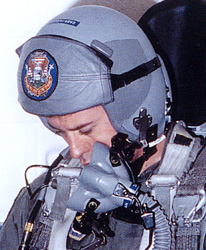 |
US Military Aviation
Flight Helmets
USAF 80s-today |
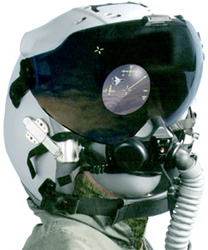 |
During the 80s modifications continued to be made as advances in aircrew protective helmet technology led to new products, incorporating both new materials and improved fabrication techniques. These modifications included communication upgrades, visor and external shell design, more comfortable internal liner and updated oxygen breathing mask systems. Advanced research on new Tactical life support systems led to a new generation of helmets for use in high performace aircraft and for Nuclear Biological Chemical protection. During the early 90s the USAF standard flight helmet HGU-55/P was modified to incorporate the COMBAT EDGE system designed to improve high performance fighter pilot tolerance to high G maneuvers.
At the beginning of 2000 the new Joint Helmet-Mounted Cueing System (JHMCS) was introduced into service to be operatively flight tested on F-15 Eagle and F-16 Fighting Falcon.
HGU-48/P
The HGU-48/P made by Gentex was the forerunner of the HGU-55/P. In the early version it was based on modified HGU-22/P shell (PRK-37/P was used in the later version). The shell was trimmed by a life support technician at Nellis Air Force Base to appease pilots complaining about the poor visibility and weight of the HGU-26/P. internal custom fit liner was normally used and dark grey leather sections were glued to the outside of the shell to provide a resting surface for the visor in the stowed positon and prevent scarring of the helmet surface when raising or lowering visor. Snap-on visor assembly attaches to the outside shell by snap fasteners on each side was utilized. Cast retainers was used to secure the MBU-5/P or MBU-12/P oxygen masks.
Back in late 1970's TAC bought 600 of these from Gentex for evaluation in the new F-15 and F-16, every pilot got a new lightweight helmet for the high-G environment so they were happy after using the old HGU-2A/P. Most were custom fit interior using the poured chemical mix, then covered in leather. There were no deficencies reported although pilot comments indicated some changes could be made to improve things and that resulted in the HGU-55/P.
The HGU-48/P also had problems with approval from SAC because they wanted dual visor capability for thermal flash protection and those were worked out in the new HGU-55/P. |
|
| USAF HGU-48/P flight helmet. Note the bungee visor and the cast oxygen mask receivers. (flightcorner.de) |
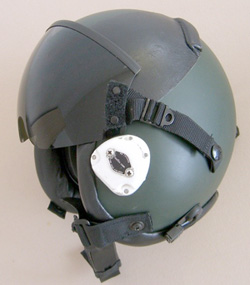
|

|
Camuflage painted HGU-48/P. (Steve Vallejo) |
| USAF HGU-48/P with Detachable Helmet Mounting Plate Assemby, AN/AVS-9 Night Vision Google (NVG) and MB-12/P oxygen mask. (DocBoink) |

|
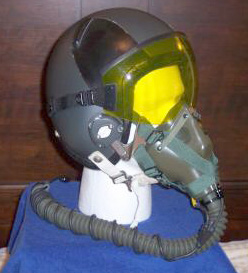
|
USAF HGU-48/P with MBU-5/P oxygen mask. |
| USAF HGU-48/P customized with HGU-55/P style grey leather edgeroll and side elements. The helmet is equipped with yellow visor, NVG mounting brackets and MB-12/P oxygen mask. |
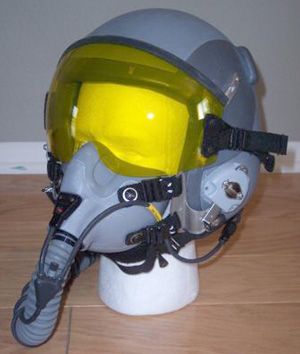
|
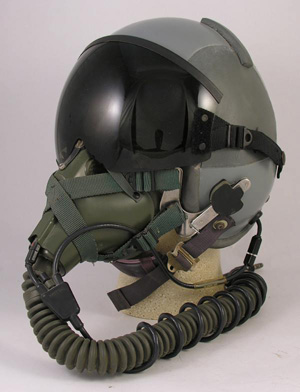
|
USAF HGU-48/P with lightweight bayonet receivers and MBU-5/P oxygen mask.(Bellsaviation.com) |
| HGU-48/P of the early 80s with US Navy MBU-14/P oxygen mask. This helmet shows an unusual double external decoration and marking being probably evaluated for USAF and US Navy utilization. |
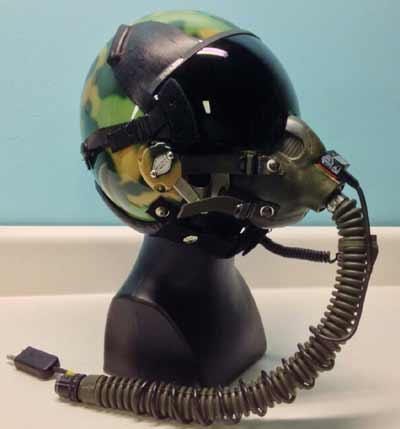
|
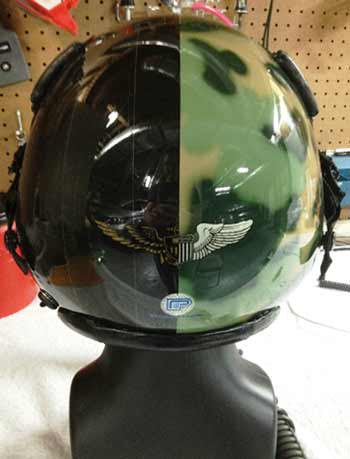
|
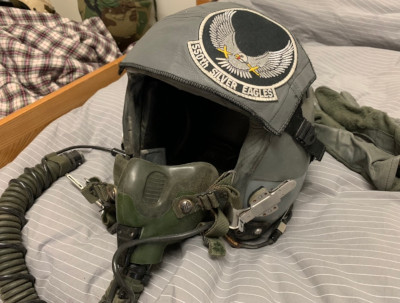
|
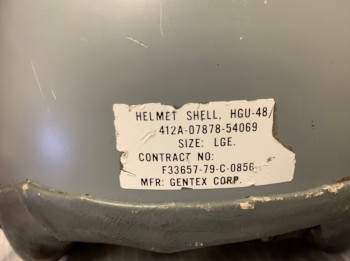
|
USAF HGU-48/P of the late 70s, early 80s with MBU-12/P oxygen mask. This helmet was awared to Gentex in 1979 for test & evaluation and used by USAF Logistic Command Program office which procured the test assets. (Matt Wesson) |
| HGU-48/P of the early 80s with MBU-5/P oxygen mask. This helmet was based on a modified HGU-22/P shell and used with PRK-40/P liner. |

|

|
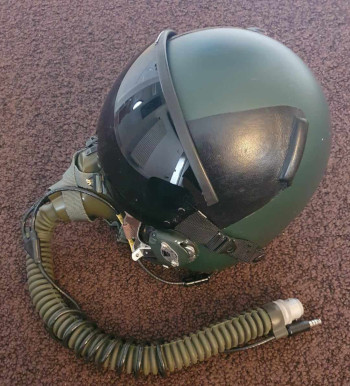
|
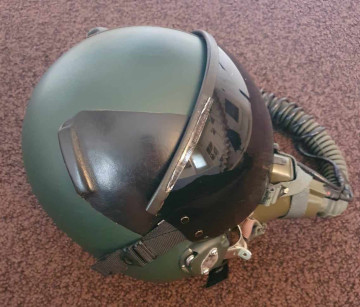
|
USAF HGU-48/P of the early 80s with MBU-5/P oxygen mask. This helmet was used by an A-10 pilot in 1982. |
 |
HGU-51/P
The HGU-51/P Integrated Chemical Defense Helmet System (ICDS) made by Gentex was produced in limited numbers mainly for F-111 and F-4 pilots in the late 70s early 80s. The system consisted of a lightweight HGU-51/P Kevlar flight helmet that featured internal cooling and ventillation systems, an internal oxygen delivery system, mounts for the EDU-2/P Nuclear Flash Protection Goggles and internal drinking facility. Worn with the helmet was a heavily modified Gentex MBU-12/P Oxygen Mask with dual valves, drinking straw, elctret microphone and TLSS style composite bayonets. The mask used a small duct that was integrated into the left side bayonet and which was fed oxygen by the helmet's internal oxygen delivery system which was supplied by a rear entry hose. Numerous visors were also offered including Clear and Neutral along with Laser Visors or the PLZT Nuclear Flash Goggles. The Visors aere designes so that they could be worn over the nuclear flash goggles as well. The twin rear entry helmet hoses connected to two more hoses that terminated in alarge friction emergency disconnect which in turn, connected to a seat mounted CRU-84/A Oxygen Regulator. Between two of the hoses was a metal C2A1 filter holder to help filter the Oxygen that was being fed to the Pilots oxygen mask. This cannister and associated hoses was secured via a quick release. A face/neck skirt cover was also used with this helmet. |
|
| USAF HGU-51/P ICDS flight helmet with EDP-2P nuclear flash protection googles . |
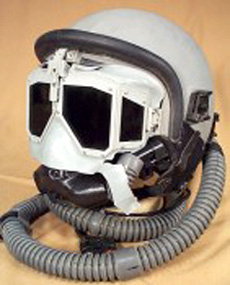
|
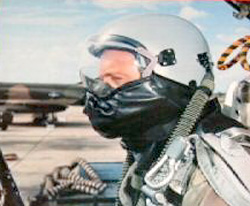
|
USAF F-4 pilot wearing an HGU-51/P with clear visor and face/neck skirt cover. (Gentex) |
| HGU-51/P with the innovative new oxygen mask design. Note the lateral duct which provide internal ventilation. (Schiffer publishing Ltd.) |
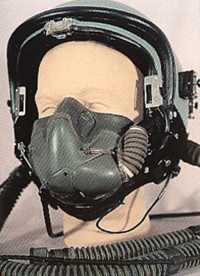
|
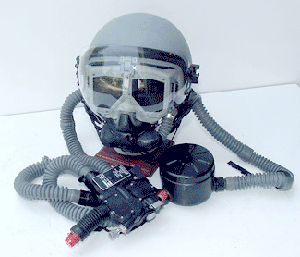
|
HGU-51/P in complete Nuclear, Biological, Chemical (NBC) mission mode with anti-flash google, clear visor and relevant filters. (Flighthelmet.com) |
| HGU-51/P with the heavily modified low profile MBU-12/P and neutral visor designed to be worn over the nuclear flash goggles |
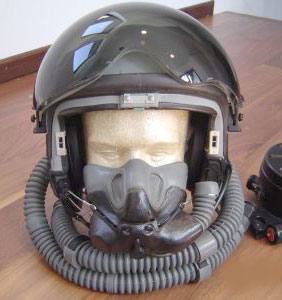
|
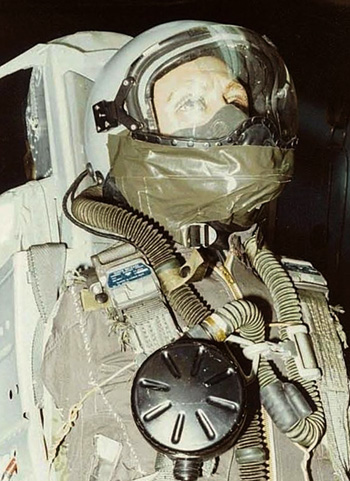
|
HGU-51/P in Nuclear, Biological, Chemical (NBC) mission mode with clear visor, mask cover and filters. |
 |
SCOTT MACH 1 HELMET
Scott Aviation's submission to replace the HGU-55/P which had a tendency to lose the visor upon ejection. This model eventually was not accepted being the HGU-53/P selected. |
|
| Ver few of Mach 1 were produced and tested. It is unknown how many examples survive. |
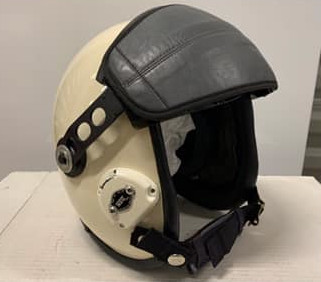
|
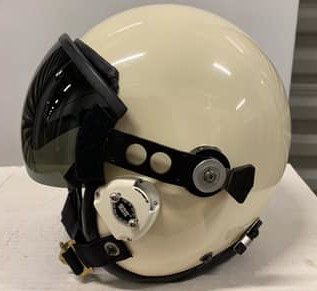
|
The Scott Mach 1 was in competion with the Gentx HGU-53/P for a replacement of the HGU-55/P but eventaully it was not selected. |
 |
HGU-53/P
The USAF HGU-53/P helmet made by Gentex was the first U.S. hemet designed with continuous locking rotary visor system that has been qualified at 600 knots equivalent airspeed (KEAS). The hemet shell is made of a light weight kevlar material, and its profile differs from the previous helmets with a reduction in external dimension for improved canopy clearance. The HGU-53/P won in competition against a Scott Mach 1 flight helmet and went into limited production, with 3 variations. The HGU-53/P is utilized with USAF standard MBU-12/P. The HGU-53/P retrofitted with COMBAT EDGE system use the MBU-20/P low profile oxygen mask. |
|
| First operational test & evaluation type of HGU-53/P with early typology of locking rotatory visor system and lighweight but "no low profile" oxygen mask receivers. (DocBoink) |
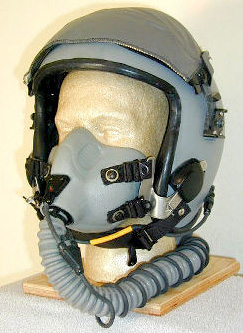
|
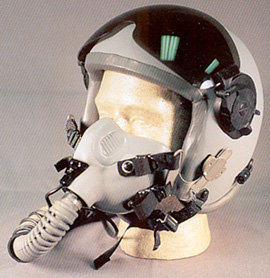
|
HGU-53/P later version with improved locking rotatory "Duck Bill" visor system and low profile oxygen mask receivers. (Schiffer publishing Ltd.) |
| USAF HGU-53/P flight helmet with locking rotatory "Daisy Wheel" visor system, oxygen mask retainers and MBU-20/P low profile oxygen mask. (neomatricks) |
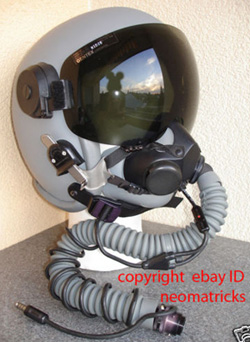
|
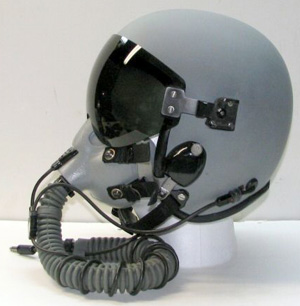
|
HGU-53/P with early type of locking rotatory visor system and MBU 12/P oxygen mask. (Surplusagent) |
| USAF HGU-53/P flight helmet with another variant of locking rotatory "Daisy Wheel" visor system, and light weight oxygen mask retainers. |
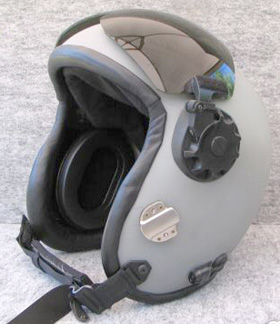
|
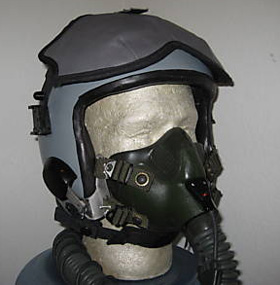
|
HGU-53/P with early type of locking rotatory visor system, shaped visor's cover and green MBU 12/P oxygen mask. (CSARdude) |
| Gentex HGU-53/P flight helmet with the early type of visor locking system and MBU-12/P incorporating a modification kit which relocates the oxygen hose to the right side to improve downward visibility (Gentex). |
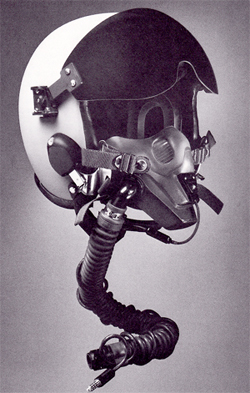
|
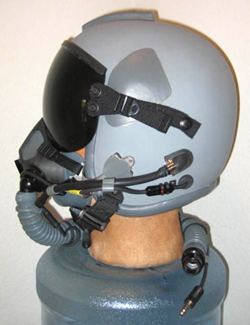
|
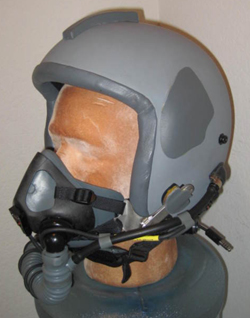
|
HGU-53/P modified with light weight wisor and Combat Edge kit. The helmet is associated with an MBU-20/P CE oxygen mask (Csardude) |
| HGU-53/P with locking rotatory "Daisy Wheel" visor system and aluminum cast bayonet receivers. The helmet is associated with an MBU-20/P oxygen mask (Csardude) |
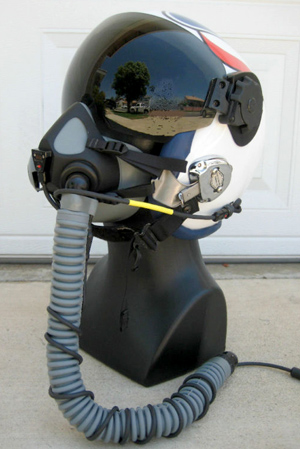
|
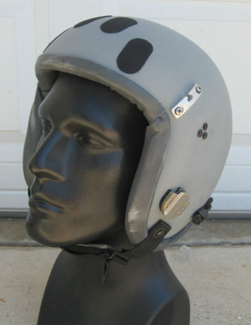
|

|
HGU-53/P with external visor removed and equipped with lateral brackets for Night vision google suspension plate installation (Csardude) |
| Gentex HGU-53/P with transparent visor |
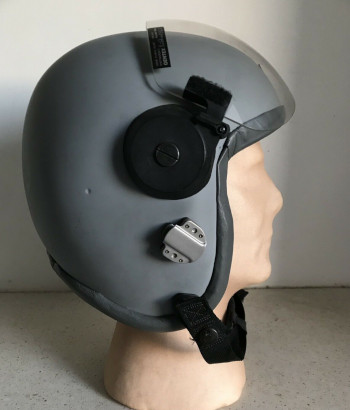
|
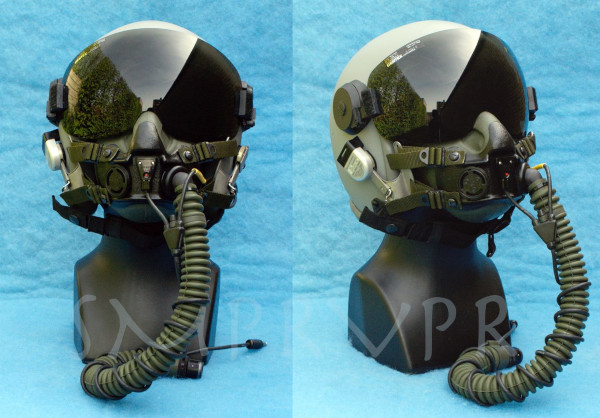
|
HGU-53/P with experimental model of MBU-12/P incorporating a modification kit which relocates the oxygen hose to the left side to improve downward visibility. |
| Gentex HGU-53/P used for ATF program on YF-22 (Philippe Tondeur collection) |
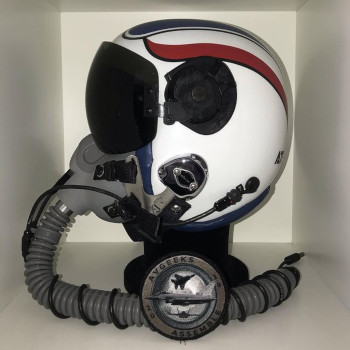
|
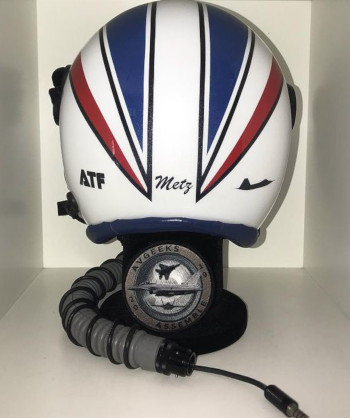
|
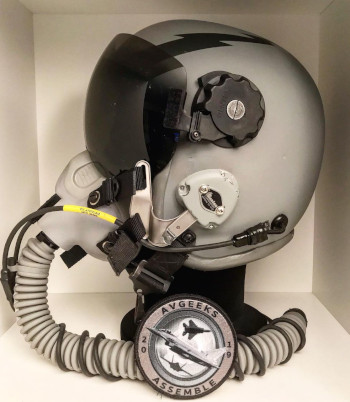
|
Other beautiful Gentex HGU-53/P (Philippe Tondeur collection) |
| Experimental flight helmet probably based on HGU-53/P shell tested on X-31 during the early-middle of the 90s. |
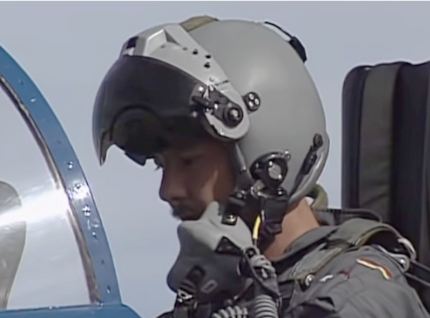
|
 |
HGU-55/P ; HGU-55/E
The HGU-55/P helmet assembly is made of fiberglass fabric molded with epoxy resin. It is equipped with energy-absorbing styrofoam liner but a custom fitted Thermoplastic liner (TPL) was also available. The helmet is equipped with a single snap-on visor that eliminates the visor housing for reduced weight and a lower profile but it is capable of accepting the PRU-36/P dual visor assembly or a single visor assembly with a housing. The HGU-55/P integrate the H-154A/AIC Headset and lightweight oxygen mask receiver kit.This helmet was normaly utilized with USAF standard MBU-5/P, MBU-12/P oxygen masks.
The HGU-55/E is identical to the standard HGU-55 except that a protective visor assembly replaces the bungee visor. Its protective visor housing allows easy movement of the impact-resistant polycarbonate lens and locks the lens securely up or down.
|
|
| USAF F-15 pilot wearing an HGU-55/P with clear visor and MBU-12/P oxygen mask. (Windrow & Greene Ltd.) |
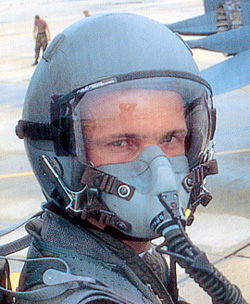
|
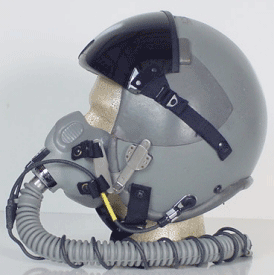
|
HGU-55/P with neutral grey visor and oxygen mask MBU-12/P. (Flighthelmet.com) |
USAF HGU-55/P with MBU-5/P oxygen mask secured with " old style" cast bayonet receivers.
(Schiffer publishing Ltd.) |
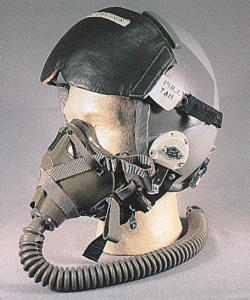
|
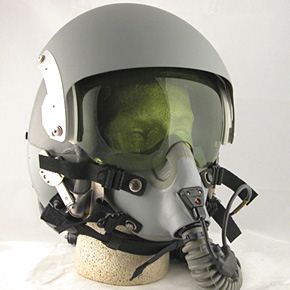
|
HGU-55/P with PRU-36/P dual visor assembly. Note the unusual green color visor.
(Chameloon Flightgear on the web) |
| HGU-55/P with MBU-5/P and dual visor assembly. The housing is equipped with a special mounting bracket used to secure the EEU-2A/P nuclear flash protection googles. (Flighthelmet.com) |
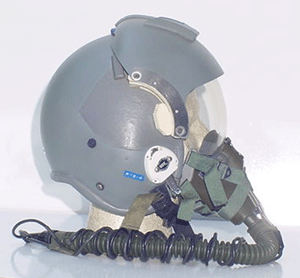
|
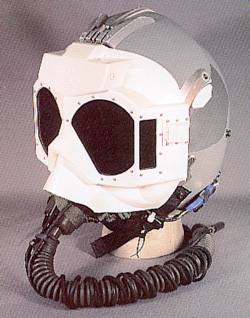
|
HGU-55/P with EEU-2A/P nuclear flash protection goggles installed and MBU-5/P. (Schiffer publishing Ltd.) |
| USAF HGU-55/P with installed the panoramic night vision goggles system. (USAF) |
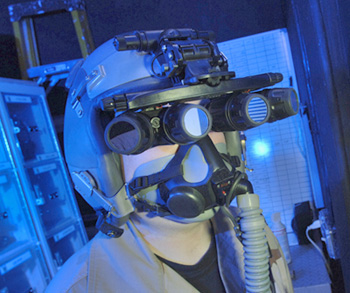
|
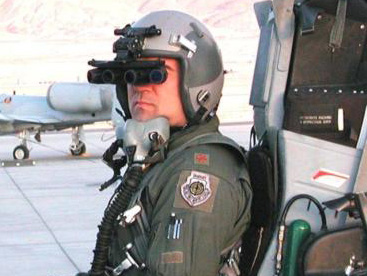
|
USAF A-10 pilot wearing an HGU-55/P with the panoramic night vision goggles system. (USAF) |
| HGU-55/E used by the USAF flight demonstration team Thunderbirds. The HGU-55/E is identical to the standard HGU-55 except that a protective visor assembly replaces the bungee visor. Its protective visor housing allows easy movement of the impact-resistant polycarbonate lens and locks the lens securely up or down. (USAF) |
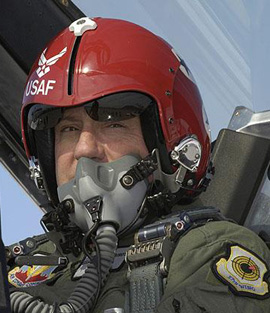
|

|
USAF HGU-55/P with dual visor assembly and MBU-12/P oxygen mask (Chameloon) |
| HGU-55/P with MBU-19/P Nuclear, Biological,Chemical, Oxygen mask and protective hood (Bellsaviation.com) |
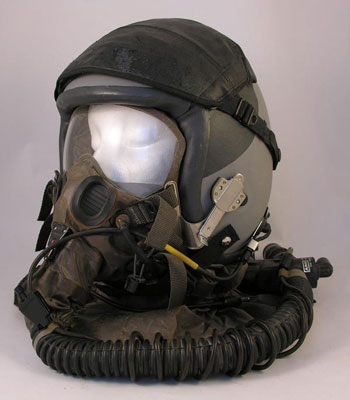
|
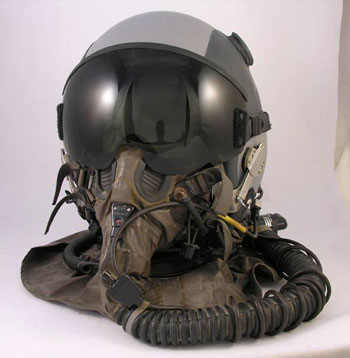
|

|
USAF HGU-55/P and EEU-2A/P nuclear flash protection googles installed and MBU-12/P, show inside the B-52 cockpit. (USAF) |
| HGU-55/P with Gentex special oxygen mask retention system (Gentex) |
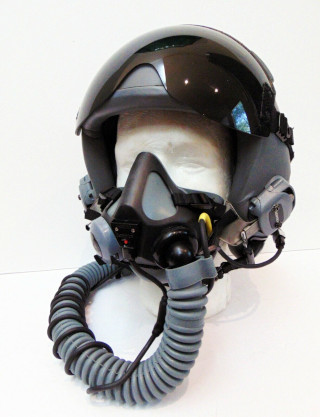
|

|
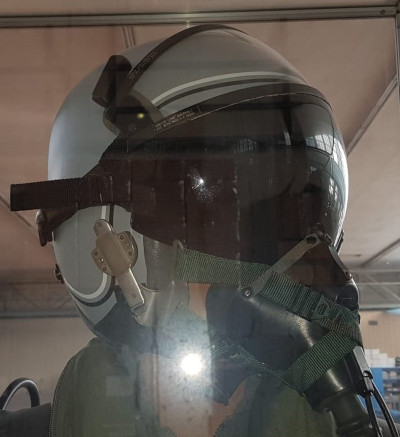
|
Gentex helmet identified as H-ATS which seems based on HGU-55/P . |
| HGU-55/P with from 65th Agressor Squadron dated 1989 with early type of MBU-20/P (Andrea Fonzi Collection) |
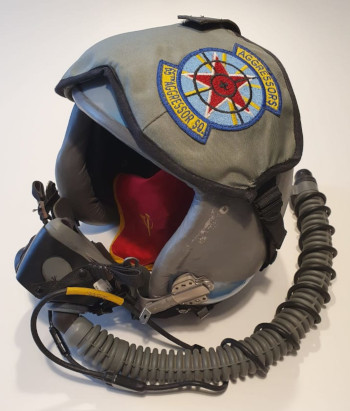
|

|
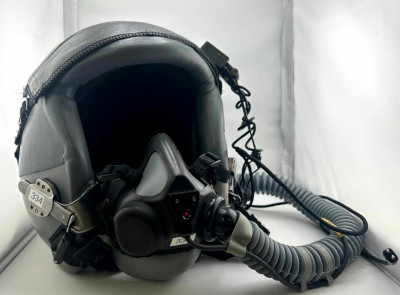
|
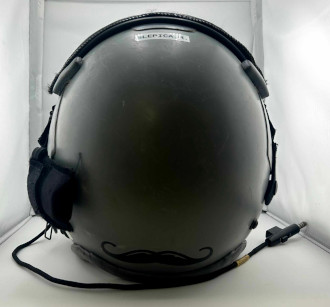
|
USAF HGU-55/P with MBU-20/P from 4th Special Operations Squadron, Eglin AFB, used on AC-130U gunship. |
 |
Tactical Life Support System (TLSS)
The USAF Tactical Life Support System (TLSS) is the precursor to the Combined Advanced Technology Enhanced Design G-Ensemble (COMBAT EDGE) and it was the first US Air Force Advanced Development life support program. The TLSS program had a wide range of research objectives that included nuclear, biological, chemical (NBC) protection, advanced anti-G protection, moderate high-altitude protection, anti-flash eye protection, aircrew cooling and personal conditioning, and on-board oxygen generation. Items of the system included an entirely new and light-weight helmets and oxygen mask system, G-suit and counter-pressure vest, nuclear flash protection goggles and NBC protective garment systems. The TLSS never reached fully operational status, however several elements tested in this program have been incorporated into the present COMBAT EDGE system. |
|
| Experimental flight combinations of TLSS system which include G-suit, counterpressure vest, light-weight helmets and early version of MBU-20/P oxygen mask. (DocBoink) |
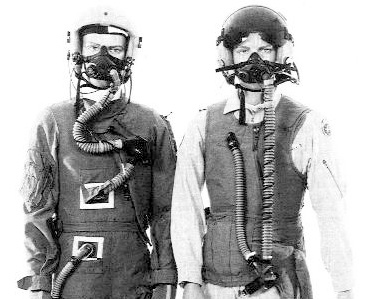
|
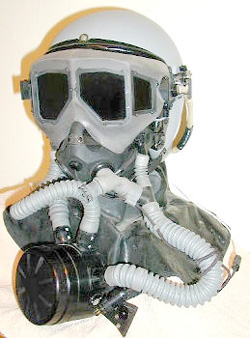
|
USAF TLSS Nuclear mission mode, with light-weight helmet, anti-flash goggles assembly and NBC integrated system. (DocBoink) |
| TLSS light-weight helmet with locking rotary visor system and low profile TLSS oxygen mask precursor of MBU-20/P. (DocBoink) |
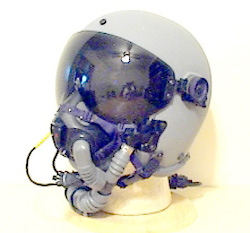
|
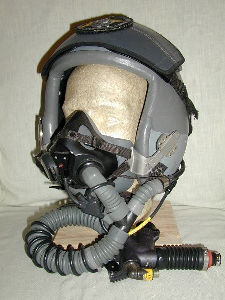
| Early USAF COMBAT EDGE design prototype based on HGU-55/P helmet and TLSS oxygen mask. (DocBoink) |
| TLSS light-weight helmet with locking rotary visor system and low profile TLSS oxygen mask precursor of MBU-20/P. |
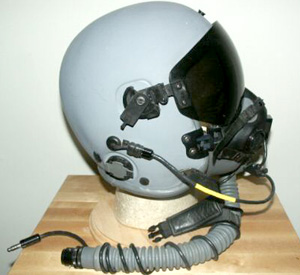
|
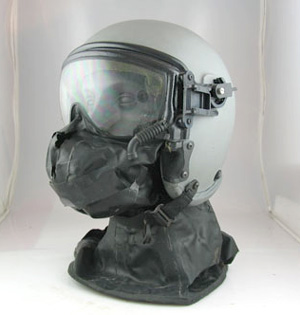
| Gentex TLSS flight helmet with low profile oxygen mask and face/neck skirt cover. (Gentex) |
Gentex TLSS helmet with low profile mask and detail of the mask's retantion system.
(hell-wings) |
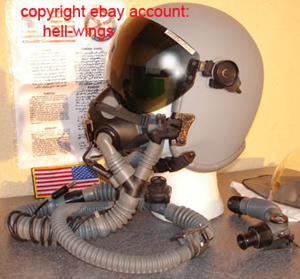
|
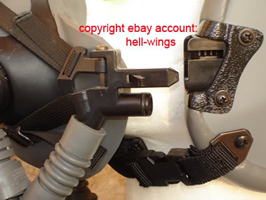
|
 |
HGU-55/P (Combat Edge)
The Combined Advanced Technology Enhanced Design G-Ensemble (COMBAT EDGE) is a pressure breating for G (PBG) system that improves a high-performance fighter pilot's tolerance to high-G maneuvers and is effective in preventing G- induced loss of consciousness (GLOC). Items of the system included, G-suit and Counter-pressure vest, Integrated Terminal Block pressure regulator, modified HGU-55/P with KMU-511/P kit and MBU-20/P low profile oxygen mask.
The complete Helmet Modification Kit KMU-511/P, designed to be easily retrofitted into standard HGU-55/P, consist of a urethane-coated nylon bladder, PBG feed tube and quick-disconnect connector, specially contoured polycarbonate visor, hook and pile fasteners. This system provides automatic mask tensioning during PBG to keep the mask in positon under pressure, but only at high G so the pilot does not have to wear the mask uncomfortably tight at all time. |
|
USAF HGU-55/P (CE) with oxygen mask MBU-20/P. Note the mask PBG tube attached to helmet's quick-disconnect connector.
(Chameloon Flightgear on the web) |
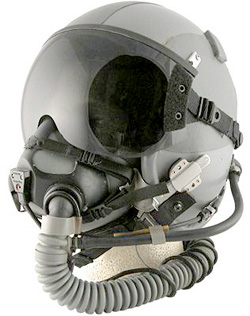
|
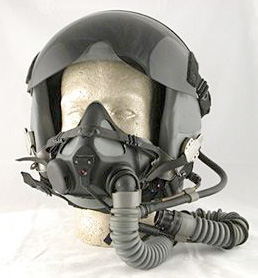
|
USAF HGU-55/P (CE) and relevant MBU-20/P. (Chameloon Flightgear on the web) |
| USAF pilot wering an HGU-55/P (CE) with installed the detachable helmet mounting plate assembly and relevant AN/AVS-9 Night Vision Goggles. (Flightgear On-Line) |
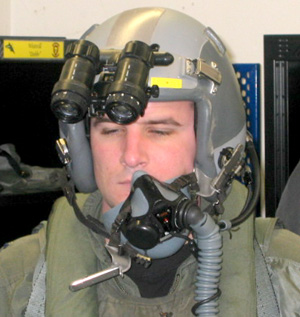
|
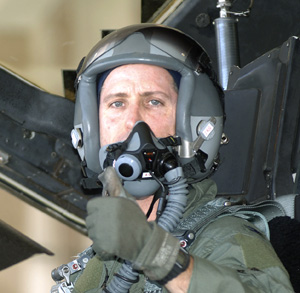
|
F-117 pilot wearing an HGU-55/P (CE) with MBU-20A/P (non combat edge hose) oxygen mask. (USAF) |
Gentex HGU-55/P (CE) with installed the detachable helmet mounting plate assembly and relevant AN/AVS-9 Night Vision Goggles' suspension bracket.
(hell-wings) |
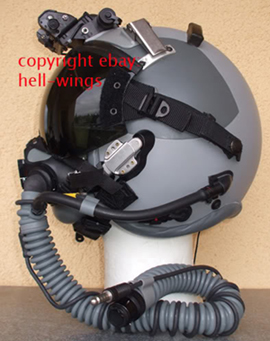
|
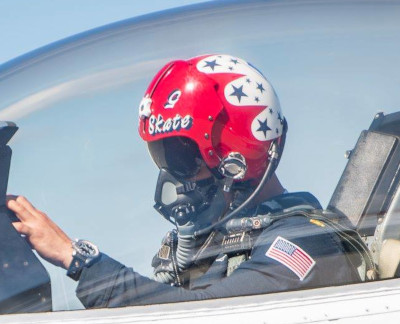
|
USAF TBird pilot wearing an HGU-55/E (CE) with MBU-20A/P oxygen mask. (USAF) |
| HGU-55/P (CE) with MBU-20A/P belong a USAF Aggressors Squadron pilot |
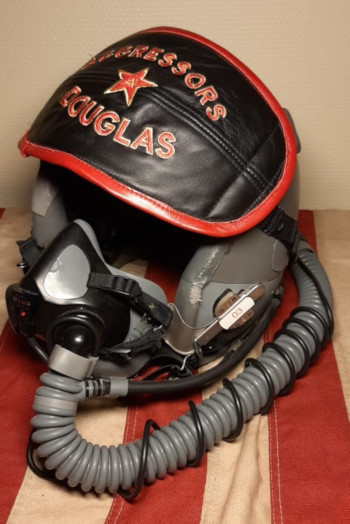
|
 |
AIR COMBAT SYSTEM
The Gentex Air Combat System or Advanced Tactical Life Support System (ATLSS) dual visor helmet is part of a fully integrated support system for tactical aircraft similar to the COMBAT EDGE system. The helmet utilizes an adjustable rotary visor mechanism. The left side mechanism controls the inner clear visor and the right side mechanism controls the outer sunshade visor. The helmet shell is constructed from an advanced lighweight Kevlar. The Air Combat System includes a modified MBU-20/P oxygen mask incorporating lighweight bayonets and receivers which provide a direct pneumatic coupling for automatic mask tensioning. the oxygen inlet hose is fitted to the right side of thefacemask, instead of the left. The other elements of the ATLSS system are the two-piece combined flight suit/anti-G, chest counter pressure garment and chest-mounted regulator. |
|
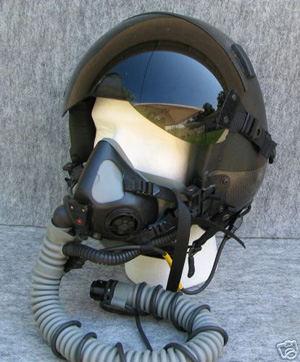
|
Rare Prototype of an Air Combat System (ACS) early ATLSS type flight helmet. This is one of the early attempts by Gentex Corp to what would later become the Combat Edge series helmets, the bladder at the rear is actually integrated into the edgeroll assembly via ducting from the mask as in the early HGU-35 of the 1970s . The mask is integrated into the edgeroll and the bladder system is inflated by the supply tube on the left side of the main hose. The shell is made of carbon fiber composite and the edgeroll is black leather and similar to the HGU-55. This helmet was a prototype built by Gentex and was used in flight testing on the YF-22 and YF-23. (Surplusagent) |
| Gentex Air Combat System flight helmet with modified MBU-20/P oxygen mask. This system was not adopted by the US Air Force due to problems of compatibility with existing systems. (Schiffer publishing Ltd.) |

|

|
Air Combat System or ATLSS flight helmet. This system has been tested in YF-22, YF-23, F-15 and F-16 aircraft. (Schiffer publishing Ltd.) |
 |
NORTHROP McDONNEL DOUGLAS AFT-23 EXPERIMENTAL HELMET
This unusual integrated full face helmet (probably also partial pressure helmet) was verly likely an house design from Northrop/MD to be tested in the 1990 on the YF-23 technology demonstrator fighter aircraft. It was probably also designed for an integrated oxygen/NBC life support system. |

|
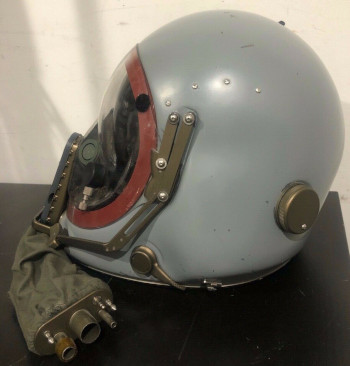
|
Very rare Northrop/MD experimental full face helmet designed to be tested on the YF-23 Black Widow in the 1990. |
| The helmet seems to have the tinted visor internally. The track for the visor is located externally on the rear top and the visor knob is very similar to the one used onthe AH-64 Apache IHADSS visor housings. |
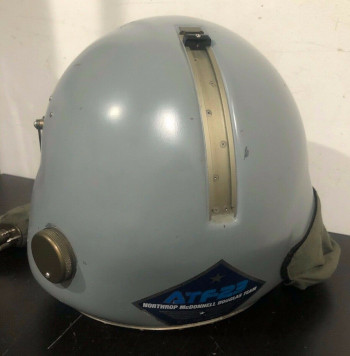
|
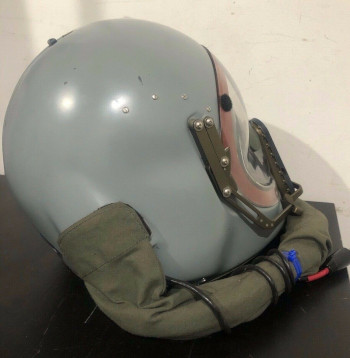
|

|
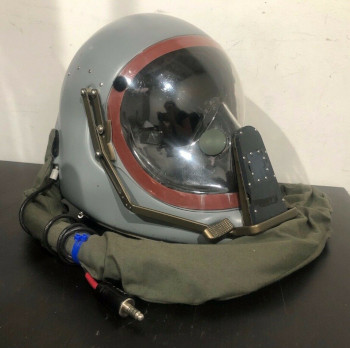
|
The helmet is equiped with standard H-154 ear cups setup and and lateral quick disconnect oxygen/pressure hose and communication cable |
 |
HGU-86/P
The HGU-86/P helmet is developed by the UK firm Helmets, Inc., in cooperation with Boeing and Gentex. This helmet has improved retention proven for ejections in excess of 600 knots, minimizing lift forces, maximum noise attenuationand universal sizing ergonometry refinements, light weight, enhanced peripheral field of vision, an improved earcup tensioning system, active PRU-57 Noise Reduction circuitry, and improved mask retention and adjustment receivers. The HGU-86/P has been designed in combination with the new (low profile, low moment of mass, and excellent visibility) MBU-22/P oxygen mask, which has an automatic mask face-seal tensioning bladder on the front of the mask and its separated inhalation and exhalation valves achieve a greatly lowered resistence to breathing. The HGU-86/P plus MBU-22/P system has been flight tested on USAF F-22 Raptor advanced fighter as well as the X-35 experimental fighter. |
|
| UK Helmets Incorporated ALPHA HGU-86/P with modified MBU-20/P oxygen mask. (Helmets Ltd.) |

|
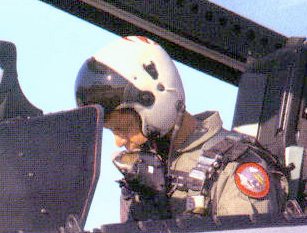
|
USAF test pilot on F-22 Raptor wearing an HGU-86/P and MBU-22/P oxygen mask. (USAF) |
| USAF pilot with new flight helmet HGU-86/P proposal for F-22 Raptor (USAF) |
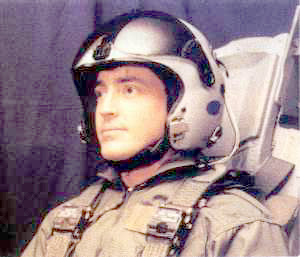
|
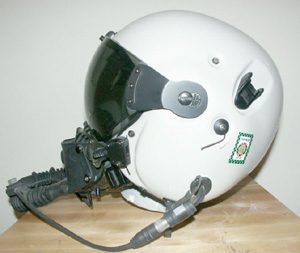
|
HGU-86/P flight helmet with MBU-22/P oxygen mask. |
| HGU-86/P with MBU-22/P oxygen mask. The MBU-22/P has been designed with a low profile, low moment of mass, and excellent visibility |
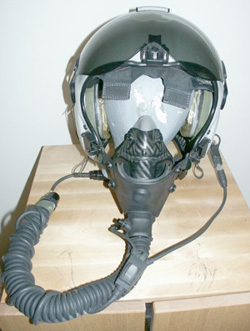
|
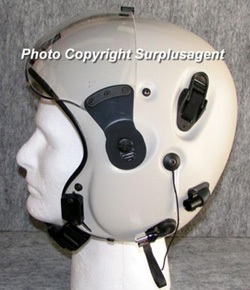
|
HGU-86/P flight helmet This model features a Combat Edge Type , Occipital Bladder and Navy type external connection for the bladder supply hose. (Surplusagent) |
| An Helmet Integrated Systems Ltd. HGU-86/P with MBU-22/P oxygen mask. (CSARdude) |
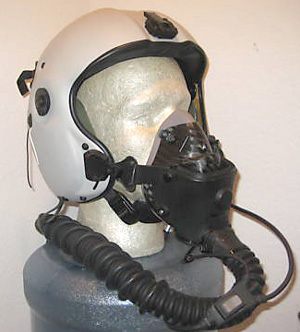
|
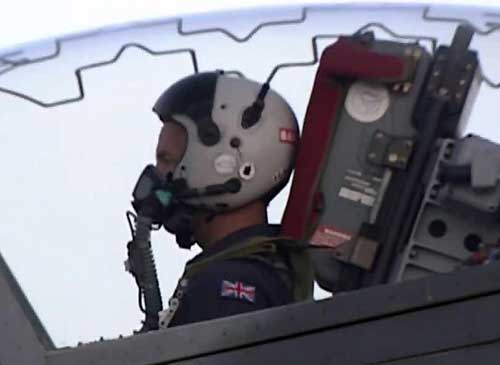
|
X-35B test pilot with HGU-86/P flight helmet and modified MBU-20/P in 2000. |
 |
JHMCS
The Joint Helmet-Mounted Cueing System (JHMCS) is intended to be used with the AIM-9X Sidewinder missile. This highly accurate cueing system provides pilots with "first look, First shot" high off-boresight weapons engagement capabilities. JHMCS enable the pilot to accurately direct (cue) the missile against enemy aircraft while performing high-G aircraft maneuvers.
The pilot needs only to point his head at the target and weapons will be directed to where the pilot is looking. The system can also be employed to accurately cue the pilot to ground target. A later version of the JHMCS helmet has been updated with a new helmet mounted queing system which has targeting technology that projects holographic data on the inside right of the visor in the form of a container, or que and allows pilots to continually survey and distinguish between friendly and enemy air and ground targets. The helmet also holsters a camera and a projector that assist pilots with air operations. The camera is embedded in the helmet and sits over the left eye, allowing servicemembers on the ground to see exactly what the pilot sees. The advantage of having this new system is the holographic image that is displayed wherever the pilot looks This helmet is utilized by US Air Force F-15 and F-16 pilots with Oxygen mask MBU-20/P.
The JHMCS is also used with the new Night Vision Cueing and Display (NVCD) This system incorporates the same symbology - including airspeed and altitude, heading, and where the aircraft sensors are looking - shown in the JHMCS into a four-tube night vision goggle. The only difference is that it is injected into a tube on the goggles overlaying the night scene. There is also a camera mounted on the goggle that records everything, which serves as a useful post-flight debrief tool. The two outer tubes can be removed creating a two-tube version, known as Mini-QuadEye.
Configuring the JHMCS for the Mini-QuadEye is easy. The goggles simply snap onto the front of the helmet and can be modified for individual preferences.
|
|
| JHMCS helmet shell and removable cueing system visor mechanism. |
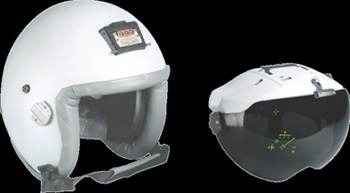
|
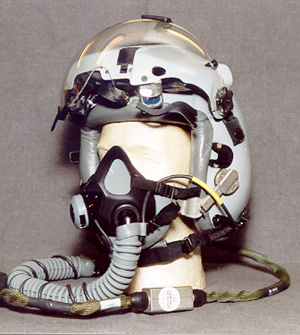
|
JHMCS helmet with MBU-20A/P (non Combat Edge hose) oxygen mask. (Bluelight) |
| JHMCS helmet without the cueing system visor mechanism. Note the interface connector (Bluelight) |
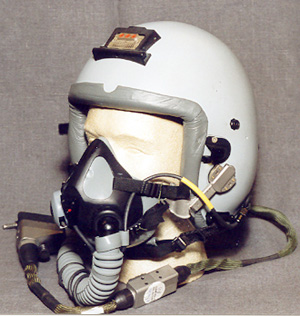
|
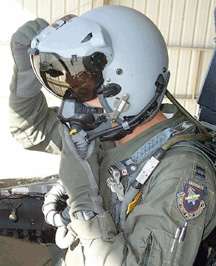
|
USAF pilot wearing a JHMCS helmet with MBU-20/P (CE) oxygen mask. (USAF) |
| USAF pilot with a JHMCS helmet and oxygen mask MBU-20/P (CE). (Flightgear On-line) |

|
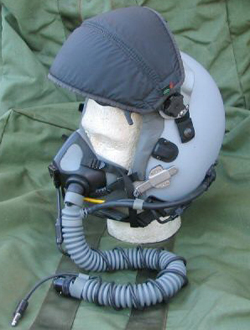
|

|
USAF JHMCS helmet with visor protection and MBU-20/P (CE) oxygen mask. |
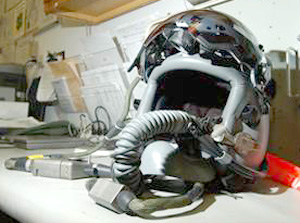
|
The JHMCS helmet updated version with a new helmet mounted queing system which has targeting technology that projects holographic data on the inside right of the visor in the form of a container, or que and allows pilots to continually survey and distinguish between friendly and enemy air and ground targets. The helmet also holsters a camera and a projector that assist pilots with air operations. The camera is embedded in the helmet and sits over the left eye, allowing servicemembers on the ground to see exactly what the pilot sees. The advantage of having this new system is the holographic image that is displayed wherever the pilot looks. (USAF) |
| JHMD helmet with the new Night Vision Cueing and Display (NVCD) This system provides Joint Helmet Mounted Cueing System (JHMCS) functionality integrated into night vision devices providing improved situational awareness for pilots during night flights. The new night vision system is a follow-on to the JHMCS, a joint effort between the Navy and the Air Force. |

|
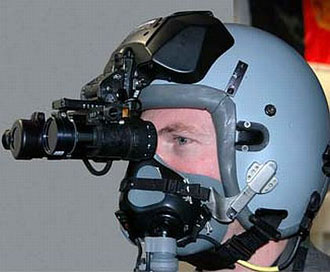
|

|
USAF F-16 pilot wearing a JHMCS helmet with the diurnal visor removed and the night vision devices bracket installed. (USAF) |
Boeing test pilot with the next-generation Joint Helmet Mounted Cueing System II/h (JHMCS II/h) on the companyís F-15 Silent Eagle demonstrator aircraft.
The JHMCS II/h allows a pilot to aim sensors and weapons wherever he or she is looking, through the use of new head-tracking technology and a display projected onto the helmetís visor. Produced by Vision Systems International (VSI), this system provides significantly improved ergonomics and reliability, at lower cost, than VSIís prior JHMCS system.
|

|
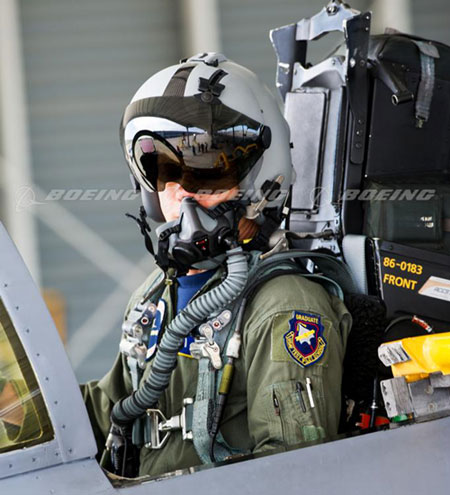
|
USAF pilot with Boeing updated version of the JHMCS flight helmet (Boeing) |
| JHMD helmet with the new Night Vision Cueing and Display (NVCD) This system provides Joint Helmet Mounted Cueing System (JHMCS) functionality integrated into night vision devices providing improved situational awareness for pilots during night flights. |
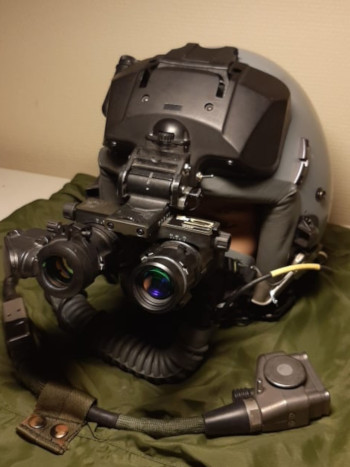
|
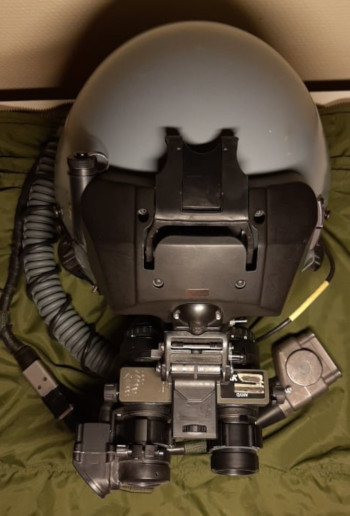
|
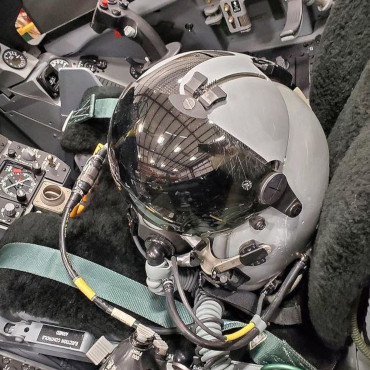
|
USAF JHMCS II helmet mounted display used on F-16 (Chris Woodul) |
 |
MODULAR AIRCREW COMMON HELMET
The Gentex Modular Aircrew Common Helmet (MACH) system is a two part concept developped from the experimental IMH (Integrated Mission Helmet). It consist of an inner "Life Support Module" (LSM) and "Outer Mission Module" (OMM). Each pilot will be issued a custom fitted LSM which will be compatible with existing aircrew oxygen mask. Outer Mission Modules will then be configured to accomodate all current and future helmet mounted equipment and displays. The goal of this system is to reduce the current inventory of 27 helmets and helmet configuration down to a single design.
|
|
| The MACH system will draw upon Gentex Corporation's capability to integrate a number of life support, display and communications capabilities into a single aircrew helmet system. These include the ability to merge the protective requirements of both rotary-wing and fixed-wing aviators into a common helmet platform as well the ability to integrate a diversity of communications equipment and head mounted electro-optical elements into a single design. Integrating all of these capabilities into a single design will enhance the ability of US aviators to perform in a variety of combat situations, lighting environments and environmental conditions. (Gentex) |

|
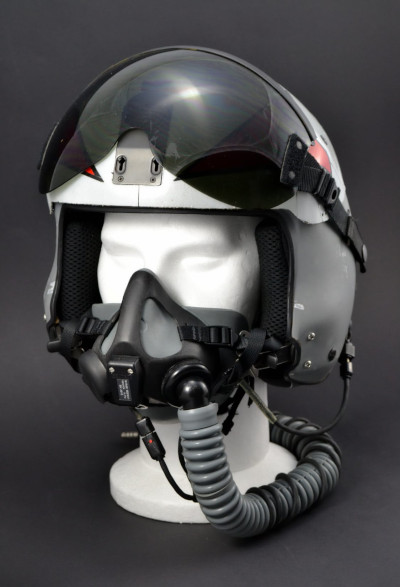
|
MACH system was intended to replace the HGU-55. The Air Force contract with Gentex included System Development and Demonstration (SDD) of the MACH with options for the SDD of module interfaces, initial operational test and evaluation, a reprocurement data package, low rate initial production (maximum of 2,250 MACH units), and two years of full rate production (maximum) of 24,000 MACH units, 500 AH-64 module interfaces, 600 JHMCS module interfaces, and 4,000 maxillofacial shields. |
| Gentex MACH system Flight Helmet dated 2020 |
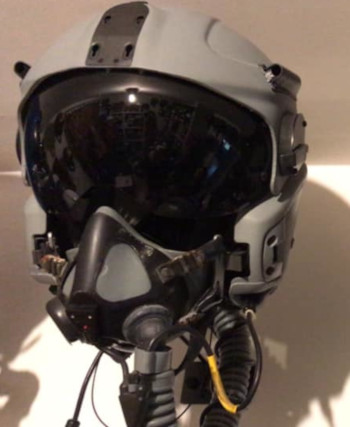
|
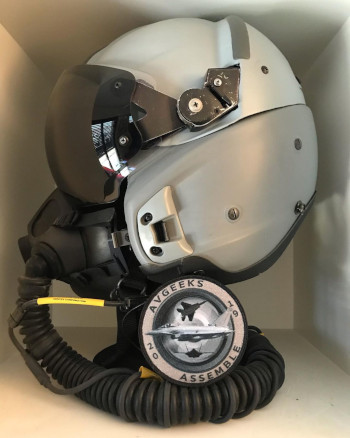
|
MACH system flight helmet (Philippe Tondeur collection). |
| Other interesting specimen of MACH system flight helmet (Philippe Tondeur collection). |
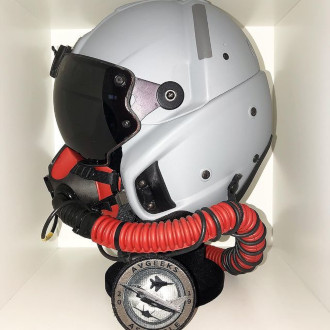
|
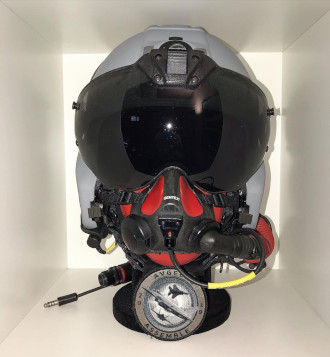
|
 |
SCORPION HELMET-MOUNTED CUEING SYSTEM
the Gentex/Raytheon Scorpion helmet-mounted cueing system. The Scorpion has been developed by GentexVisionix, with systems integration provided by Raytheon.
It is a monocle-based system that has both fixed- and rotary-wing applications, with minimal airframe intrusion, requiring just a single, small interface control unit and one magnetic sensor mounted in the cockpit.
Scorpion provides the pilot with a variety of data in the display, from HUD-style flight information to colour imagery from sensors. The display can be set to remain forward- facing, or can track as the pilot moves his or her head. Advanced processing provides a fast refresh rate, in turn providing seamless imagery as the head moves, with no time lag.
Among the capabilities of the system, which is fully integrated with the aircraftís avionics, is the ability to provide GPS co-ordinates of designated points for targeting or handing off to other platforms.
Using a monocle system over more expensive full-visor projection has several advantages, both in operational terms and in cost. The display can be swung out of the way if it is not required, and its small size imposes no extra weight burden on the pilotís head. The system fits on to the standard Gentex helmet, and is interchangeable between helmets, so that fewer have to be purchased to equip a unit. Another advantage is that it works with standard night-vision goggles, which can be swung down in front of the monocle display.
|
|
| Scorpion has already found two applications in the US Air Force, and it is being proposed to equip the Air National Guardís A-10 and F-16 fleets. It has also aroused much interest in the export market. The system is being demonstrated on th Raytheon stand (Hall 1, C154). (Gentex) |

|
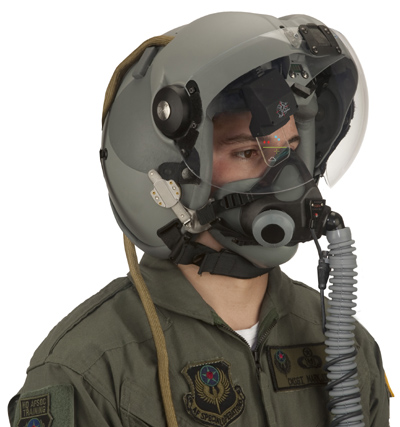
|
HGU-55/P integrated with the Scorpion system and a special clear visor |
| A-10 pilot with HGU-55/P CE flight helmet integrated with the Gentex Scorpion System. (USAF) |

|
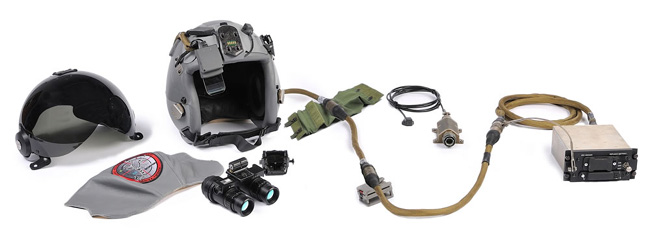
|
Gentex Scorpion System components overview (Gentex) |
| HGU-55/P CE flight helmet integrated with the Gentex Scorpion System. (Gentex) |

|

|
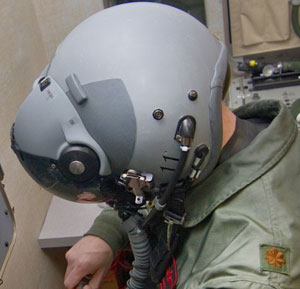
|
USAF F-16 pilots with Gentex Scorpion System and MBU-20/P (CE) oxygen mask. |
| USAF A-10 pilot and F-16 pilots with with Gentex Scorpion System and MBU-20/P (CE) oxygen mask. The A-10 pilot helmet has the external visor removed and the Scorpion System components are visible. |
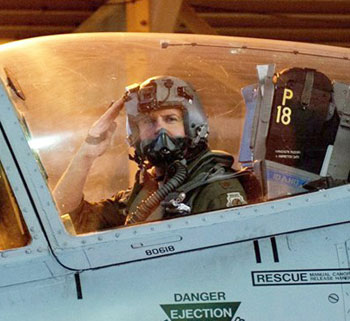
|
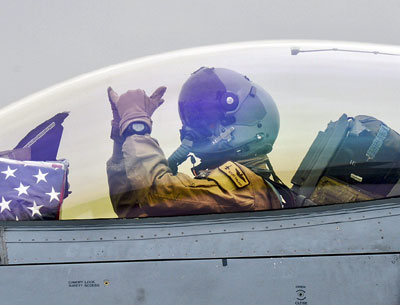
|
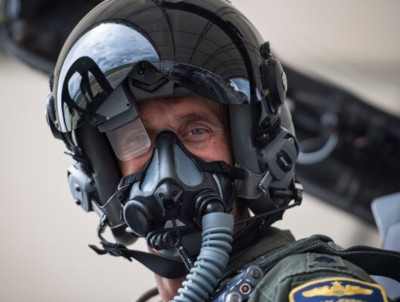
|
USAF A-10 pilot with modified HGU-55/P integrating the Gentex Scorpion System and new anti-snap oxygen mask retainers and MBU-20/P oxygen mask. |
 |
LifeBEAM Monitoring Helmet
The Pilots & Astronauts monitoring helmet was developed with the cooperation of the Israeli Air Force (IAF) as the first product in the world to monitor pilots during flight.
LifeBEAMís optical technology is integrated into Fighter Pilot helmets and measures blood flow (perfusion), pulse rate, and SpO2.
LifeBEAMís state of the art algorithms are integrating several sources of information: pilotís physiology, aircraftís physics (G-forces, velocity, altitude & positioning) and pilotís head & body postures. Based on the above data and by using machine learning & neural network methods, the system automatically detects life-threatening situations, such as Hypoxia, A-LOC and G-LOC in real-time.
When the system identifies a development of a dangerous situation, it provides an immediate alert to both air & ground crew. The system also enables integration with aircraftís systems such as automatic pilot & flight debriefing tools.
The system was evaluated during F-16 flights, centrifuge trainings, NASAís training facilities and in hypobaric chambers.
|
|
LifeBEAMís optical technology is integrated into Fighter Pilot helmets and measures blood flow (perfusion), pulse rate, and SpO2.
LifeBEAMís state of the art algorithms are integrating several sources of information: pilotís physiology, aircraftís physics (G-forces, velocity, altitude & positioning) and pilotís head & body postures. (LifeBEAM)
|

|
 |
HMDS
Vision System International LLC is now under contract to develop the Helmet Mounted Display System (HMDS) for the F-35 Joint Strike Fighter aircraft. Some of the features that will be provided by this next generation helmet system include: Binocular Wide Field-of-View, Integrated day/night capability with sensor fusion, Highly accurate head tracking hardware and software, Digital image source for helmet vision displayed symbology, Custom helmet shell, liner and suspension system for lightest weight, optimal C.G. and maximum pilot comfort.
|
|
HMDS proposal for F-35 Joint Strike Fighter developed by VSI.
(Vision Systems International LLC) |
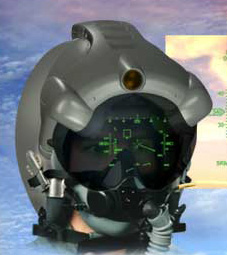
|
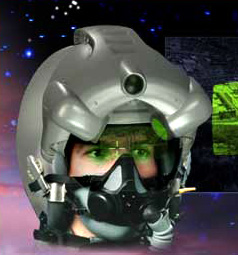
|
The HMDS represent the next generation of Mounted display flight helmet system with binocular wide field and integrated day/night capability.
(Vision Systems International LLC) |
| Experimental HMDS tested on F-35 Joint Strike Fighter. The HMDS also provides HUD information as though pilots are looking through an actual HUD no matter in what direction they turn their heads. (USAF) |
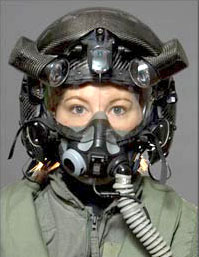
|
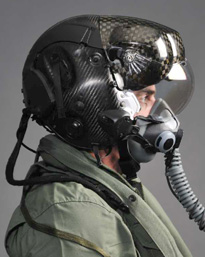
|
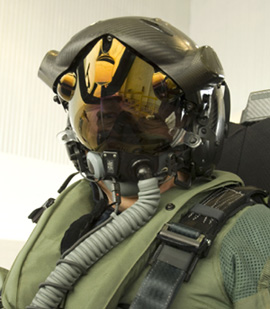
|
Developing the F-35 JSF HMDS has presented tough challenges, particularly clearing the helmet-mounted optics for safe ejection at speeds up to 450kt (830km/h). VSI says the HMDS demonstrated structural integrity up to 600kt in tests leading to flight certification.The HMDS was used by chief test pilot Jon Beesley for the first time on the 10th test flight of the F-35 (USAF) |
| Rear view of the HMDS tested on F-35 Joint Strike Fighter. |
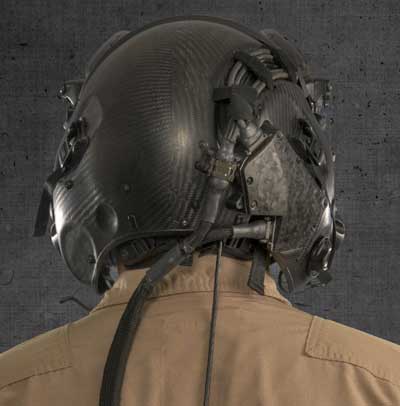
|
 |
Next Generation Fixed Wing Helmet (NGFW)
Gentex Corporation, a global leader in personal protection and situational awareness solutions for defense forces, aircrew, emergency responders, and industrial personnel, announced today that it delivered 40 helmets in multiple configurations as initial qualification test assets of the Next Generation Fixed Wing Helmet (NGFW) System.
Gentex was awarded the NGFW OTA Agreement by the United States Air Force in February 2020.
This is the first of three rounds of testing to be performed on the NGFW helmet. In addition to United States Air Force qualification testing, Gentex performed its own testing to ensure highest levels of quality and protection. Testing will be conducted on both the JHMCS and NVG (Slick) configurations.
The Gentex NGFWH System fully integrates the latest Gentex advancements and innovation in all facets of helmet system design and integration, including the helmet system itself, optics, hearing protection, communications and situational awareness, respiratory protection integration and helmet mounted device integration. The NGFWH System will provide a higher level of protection and operational capability for current and future aircrew.
|
|
| Gentex Next Generation Fixed Wing Helmet (NGFW) System (Gentex) |
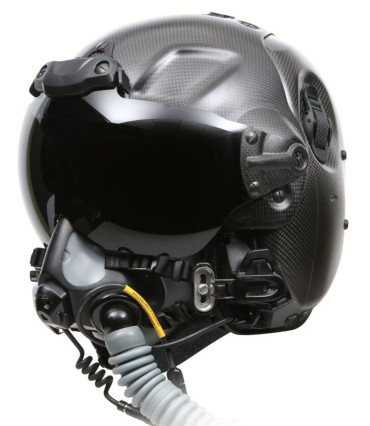
|
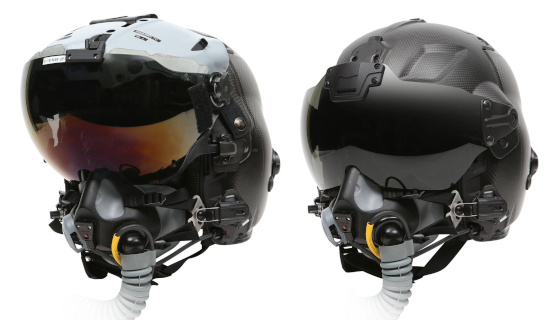
|
Gentex Next Generation Fixed Wing Helmet (NGFW) System with helmet-mounted cueing system (HMCS).
| |
 |
LIFT Airborne Technologies AV 2.2 helmet
The Air Force has selected a prototype to develop as its new helmet for all fixed-wing aircrew, Air Combat Command announced June 25, picking LIFT Airborne Technologiesí design.
The new helmet, which still has to undergo additional research and testing before the Air Force confirms the design and offers a production contract, is better equipped to handle the addition of helmet-mounted devices and will offer a better fit for more diverse crews. LIFT touts its design, called AV 2.2, as being substantially lighter than competitors, with increased ventilation and custom fitting options available. The helmet also has a modular design, making it easier to attach devices such as night-vision goggles or a helmet-mounted cueing system (HMCS).
|
|
| LIFT AV 2.2 new thecnology flight helmet (LIFT Airborne Thecnology) |

|
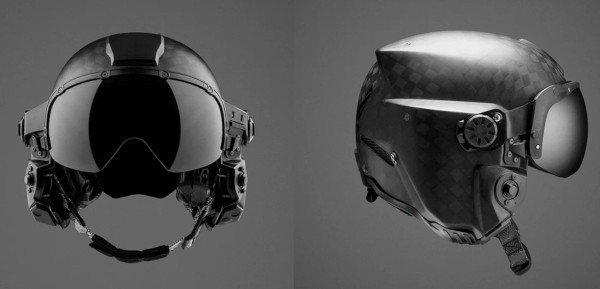
|
LIFT prototype flight helmet AV 2.2 Among those requirements for this new generation helmet were: weight, pilot comfort, optimized fitment and protection, stability, optimized center of gravity, and integration with different helmet-mounted systems. |
| LIFT prototype flight helmet AV 2.2 was tested by the Air Force Research Laboratory, other labs at Wright-Patterson Air Force Base, Ohio, and squadrons at Eglin Air Force Base, Fla. |
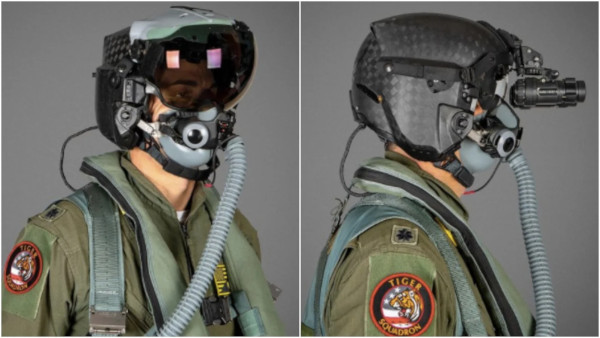
|
 |
|










































































































































